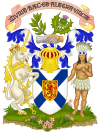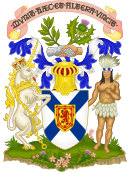Politics of Nova Scotia
Politics of Nova Scotia | |
|---|---|
 | |
| Polity type | Province within a federal parliamentary constitutional monarchy |
| Constitution | Constitution of Canada |
| Legislative branch | |
| Name | General Assembly |
| Type | Unicameral |
| Meeting place | Province House, Halifax |
| Presiding officer | Speaker of the House of Assembly |
| Executive branch | |
| Head of State | |
| Currently | King Charles III represented by Arthur LeBlanc, Lieutenant Governor |
| Head of Government | |
| Currently | Premier Tim Houston |
| Appointer | Lieutenant Governor |
| Cabinet | |
| Name | Executive Council |
| Leader | Premier (as President of the Executive Council) |
| Appointer | Lieutenant Governor |
| Headquarters | Halifax |
| Judicial branch | |
| Court of Appeal | |
| Chief judge | Michael Wood |
| Seat | Law Courts, Halifax |
The politics of Nova Scotia take place within the framework of a Westminster-style parliamentary constitutional monarchy. As Canada's head of state and monarch, Charles III is the sovereign of the province in his capacity as King in Right of Nova Scotia; his duties in Nova Scotia are carried out by the Lieutenant Governor, Arthur LeBlanc. The General Assembly is the legislature, consisting of the Lieutenant Governor and fifty-five members representing their electoral districts in the House of Assembly.[1] The Government is headed by the Premier, Tim Houston, who took office on August 31, 2021. The capital city is Halifax, home to the Lieutenant Governor, the House of Assembly, and the Government. The House of Assembly has met in Halifax at Province House since 1819.[2]
Monarchy[edit]
The role of the Crown is both legal and practical; it functions in Nova Scotia in the same way it does in all of Canada's other provinces, being the centre of a constitutional construct in which the institutions of government acting under the sovereign's authority share the power of the whole.[3] It is thus the foundation of the executive, legislative, and judicial branches of the province.[4] The Canadian monarch—since 8 September 2022, King Charles III—is represented and his duties carried out by the lieutenant governor of Nova Scotia, whose direct participation in governance is limited by the conventional stipulations of constitutional monarchy, with most related powers entrusted for exercise by the elected parliamentarians, the ministers of the Crown generally drawn from among them, and the judges and justices of the peace.[5]
Legislative power[edit]
The Nova Scotia House of Assembly (French: Assemblée législative de la Nouvelle-Écosse; Scottish Gaelic: Taigh Seanaidh Alba Nuadh), or Legislative Assembly, is the sole chamber of the unicameral General Assembly of Nova Scotia. The assembly is the oldest in Canada, having first sat in 1758;[6] in 1848, it was the site of the first responsible government in the British Empire. Bills passed by the House of Assembly are given royal assent by the Lieutenant Governor of Nova Scotia[7] in the name of the King in Right of Nova Scotia.
When established in 1758, the General Assembly consisted of the Crown represented by the Governor (Lieutenant Governor post-confederation), the appointed Nova Scotia Council holding both executive and legislative duties and the elected House of Assembly (lower chamber). In 1838, the Council was replaced by an executive council with the executive function and a legislative council with the legislative functions based on the House of Lords. In 1928, the Legislative Council was abolished and the members pensioned off, resulting in a unicameral legislature with the House of Assembly as the sole chamber.
There are 55 members of the legislative assembly (MLAs) representing 55 electoral districts.[8] Members nearly always represent one of the three main political parties of the province: the Nova Scotia Liberal Party, the Progressive Conservative Association of Nova Scotia, and Nova Scotia New Democratic Party.
Executive power[edit]
The Government of Nova Scotia exercises the executive power. The chief body of the Government is the Executive Council, also known as Cabinet.[9] The Premier of Nova Scotia is President of the Executive Council.[9]
Electoral history[edit]
1867 to 1916[edit]
| Government | Anti Confederation | Liberal | Con | Liberal | ||||||||||
| Party | 1867 | 1871 | 1874 | 1878 | 1882 | 1886 | 1890 | 1897 | 1897 | 1901 | 1906 | 1911 | 1916 | |
|---|---|---|---|---|---|---|---|---|---|---|---|---|---|---|
| Liberal | 36 | 24 | 22 | 6 | 24 | 28 | 29 | 25 | 34 | 36 | 32 | 26 | 31 | |
| Conservative | 2 | 14 | 12 | 32 | 14 | 10 | 9 | 13 | 3 | 2 | 4 | 12 | 12 | |
| Independent | 4 | 1 | 2 | |||||||||||
| Total | 38 | 38 | 38 | 38 | 38 | 37 | 38 | 37 | 38 | 38 | 38 | 38 | 43 | |
1920 to 1967[edit]
| Government | Liberal | Con | Liberal | PC | ||||||||||
| Party | 1920 | 1925 | 1928 | 1933 | 1937 | 1941 | 1945 | 1949 | 1953 | 1956 | 1960 | 1963 | 1967 | |
|---|---|---|---|---|---|---|---|---|---|---|---|---|---|---|
| Liberal | 29 | 3 | 18 | 22 | 25 | 22 | 28 | 27 | 22 | 18 | 15 | 4 | 6 | |
| Conservative | 3 | 40 | 24 | 8 | 5 | 5 | ||||||||
| Progressive Conservative | 8 | 13 | 24 | 27 | 39 | 40 | ||||||||
| United Farmers | 6 | |||||||||||||
| Labour | 5 | 1 | ||||||||||||
| Cooperative Commonwealth Federation | 3 | 2 | 2 | 2 | 1 | 1 | ||||||||
| Total | 43 | 43 | 43 | 30 | 30 | 30 | 30 | 37 | 37 | 43 | 43 | 43 | 46 | |
1970 to present[edit]
| Government | Liberal | PC | Liberal | PC | NDP | Liberal | PC | |||||||||
| Party | 1970 | 1974 | 1978 | 1981 | 1984 | 1988 | 1993 | 1998 | 1999 | 2003 | 2006 | 2009 | 2013 | 2017 | 2021 | |
|---|---|---|---|---|---|---|---|---|---|---|---|---|---|---|---|---|
| Liberal | 23 | 31 | 17 | 13 | 6 | 21 | 40 | 19 | 11 | 12 | 9 | 11 | 33 | 27 | 17 | |
| Progressive Conservative | 21 | 12 | 31 | 37 | 42 | 28 | 9 | 14 | 30 | 25 | 23 | 10 | 11 | 17 | 31 | |
| New Democratic | 2 | 3 | 4 | 1 | 3 | 2 | 3 | 19 | 11 | 15 | 20 | 31 | 7 | 7 | 6 | |
| Cape Breton Labour | 1 | 1 | 1 | |||||||||||||
| Independent | 1 | |||||||||||||||
| Total | 46 | 46 | 52 | 52 | 52 | 52 | 52 | 52 | 52 | 52 | 52 | 52 | 51 | 51 | 55 | |
Of the registered voters in 2017, 53.4% voted. Voter turnout has decreased from 82% turnout in 1960.[10]
Federal elections from 1968 to 2021[edit]
| Party | 1968 | 1972 | 1974 | 1979 | 1980 | 1984 | 1988 | 1993 | 1997 | 2000 | 2004 | 2006 | 2008 | 2011 | 2015 | 2019 | 2021 | |
|---|---|---|---|---|---|---|---|---|---|---|---|---|---|---|---|---|---|---|
| Liberal | 1 | 1 | 2 | 2 | 6 | 2 | 6 | 11 | 4 | 6 | 6 | 5 | 4 | 11 | 10 | 8 | ||
| PC | 10 | 10 | 8 | 8 | 5 | 9 | 5 | 6 | 4 | |||||||||
| NDP | 1 | 1 | 6 | 3 | 2 | 2 | 2 | 3 | ||||||||||
| Reform / Alliance | ||||||||||||||||||
| Conservative | 3 | 3 | 3 | 4 | 1 | 3 | ||||||||||||
| Total | 11 | 11 | 11 | 11 | 11 | 11 | 11 | 11 | 11 | 11 | 11 | 11 | 11 | 11 | 11 | 11 | 11 | |
See also[edit]
- Monarchy in Nova Scotia
- Lieutenant Governor of Nova Scotia
- Premier of Nova Scotia
- General Assembly of Nova Scotia
- Nova Scotia House of Assembly
- List of Nova Scotia general elections
- Government of Nova Scotia
- Executive Council of Nova Scotia
- Council of the Federation
- Politics of Canada
- Political culture of Canada
References[edit]
- ^ "About the Legislature". Nova Scotia Legislature. 2016-09-06. Retrieved 2018-07-15.
- ^ Province of Nova Scotia (2009). "Province House, Halifax, Nova Scotia" (PDF). Nova Scotia Legislature.
- ^ Cox, Noel (September 2002). "Black v Chrétien: Suing a Minister of the Crown for Abuse of Power, Misfeasance in Public Office and Negligence". Murdoch University Electronic Journal of Law. 9 (3). Perth: Murdoch University: 12. Retrieved 17 May 2009.
- ^ Privy Council Office (2008), Accountable Government: A Guide for Ministers and Ministers of State – 2008, Ottawa: Queen's Printer for Canada, p. 49, ISBN 978-1-100-11096-7, archived from the original on 18 March 2010, retrieved 17 May 2009
- ^ MacLeod, Kevin S. (2008). A Crown of Maples (PDF) (1 ed.). Ottawa: Queen's Printer for Canada. p. 16. ISBN 978-0-662-46012-1. Retrieved 21 June 2009.
- ^ How Canadians Govern Themselves
- ^ Constitution Act, 1867, ss. 69 & 88; Nova Scotia House of Assembly
- ^ Chapter 32 of Nova Scotia Acts of 2019
- ^ a b admin (2017-06-23). "Cabinet". Nova Scotia Legislature. Retrieved 2024-01-20.
- ^ Chief Electoral Officer (30 May 2017). "Statement of Votes and Statistics: Volume 1" (PDF). Elections Nova Scotia.

